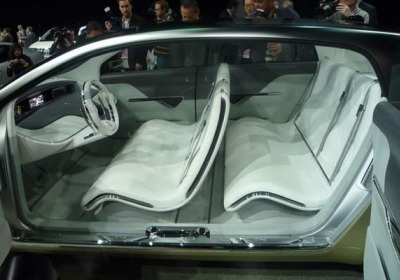At the Detroit Auto Show, Lincoln gets a C
Mon, 12 Jan 2009Hoping to attract younger buyers, Ford's Lincoln division unveiled the Lincoln C concept at the Detroit Auto Show this week, a car Lincoln calls a big idea for a small luxury car. Ford's vision: a small, more fuel-efficient car for congested urban areas and compact parking spaces that still provides driver and passengers with luxury and comfort of larger sedans.
"Modern luxury buyers who live and work in large, urban areas want to play their part in helping the environment by moving to a smaller vehicle, but they still want to enjoy the luxuries of life," said Peter Horbury, executive director of Design, The Americas. "The Lincoln C offers sensible indulgence. During the past decade, people have gotten used to the idea that you could pay more money for a smaller version of the real thing," said Horbury, citing the evolution of music players from tapes to CDs to MP3 players as an example. He said the same philosophy can be applied to cars.
Thus, the C. Ford hopes the concept's size, lightweight construction and use of sustainable materials make the Lincoln C stand out.
The C rides on a modified European Focus platform and is powered by a turbocharged 1.6-liter, direct-injection EcoBoost four, producing 180 hp and 180 lb-ft of torque. The engine is mated to a six-speed twin clutch transmission. The car has a stop-start feature, and Lincoln said it will get 43 mpg on the highway.
The car's low shoulder line makes it look low and wide. It is about as long as the Focus but as wide as the Lincoln MKZ. The front end is definitely all Lincoln, while the rear is Renault-esque. There is no B-pillar or center post. The center-opening doors--a classic Lincoln trait from the 1961 Continental--allow access to first- and second-row bench seats.
Note that we said first row bench seat. Yes, the C is a six-seater and the absence of a B-pillar makes it look huge inside. The all-white interior is trimmed in leather and recyclable wood. One of the seats' more eye-catching elements is the laser-engraved floral etching on the passenger side and floor and on the back of the driver's seat.
The steering wheel has no center hub so the driver can see the instrument panel unobstructed. The white rim rotates around a stationary chrome ring with chrome shifter paddles.
The instrument panel is divided into three sections and has a mix of digital and analog instruments. The left side has menus and driver-related information. The center displays a screen with navigation, SYNC details, hands-free, voice-activated cell phone, text messaging, and digital media player and 911 assist.
Not enough gizmos for you? Then you'll be pleased to hear the C uses a life-like avatar to connect the driver to the car and all the functions offered through Ford's HMI (human-machine interface) and SYNC.
On a small screen on the instrument panel, the avatar--nicknamed "EVA"--takes on a human-like visual image and personality. She responds to conversational speech, so there are no menus or voice commands. EVA manages and initiates all vehicle and SYNC functions and information to the driver. And finally, you guessed it, she can sense your mood through voice and drive style and will respond with, say, a favorite song from a SYNC-connected MP3 music library.
Of course there's in-car Internet access, so she can surf the Web for you and read you the morning's online news headlines or restaurant reviews. She can check e-mail, or access a friend's Facebook page.
Whew!
So, what are the chances of the C being produced? About zero, right? This is just a concept for the Detroit Auto Show. Well, Ford sources say a Mercury will come to market on this platform first, though a Lincoln is definitely being considered.
If it is produced, Lincoln will take a step toward proving that small on the outside/big on the inside can work for a premium brand.
Detroit Auto Show News
By Wes Raynal



